R&R Consult conducted a CFD analysis of a Once Through Steam Generator (OTSG) for Innovative Steam Technology Inc. in Cambridge, Ontario, Canada. The OTSG is with supplementary firing from 5 grid burners from De Jong Combustion b.v. in The Netherlands. Our task was to provide a comprehensive analysis of temperature, flow and radiation distribution at the super heater. The surface temperature of the super heater tubes is a crucial parameter when selecting proper material and avoiding tube damages and wear.
R&R Consult also designed flow correctional devices (FCDs) for optimum operational conditions for the grid burners and even temperature distribution upstream the super heater tubes in full- and part-load operation simulations were carried out at full load, 65% and 50% part load operation. For the analysis, we used measured GT inlet profiles as inlet conditions. All scenarios showed an uneven flow distribution with a pair of vortices, which generated a rotating flow upwards toward the burners. The flow changed considerably, depending on load. With the increasing demands for part load operation, this stresses the importance of well-designed heat recovery steam generators that perform optimally during cycling. Our analysis of the fully modeled Super Heater (SH) tubes and fins provided detailed information about temperature, convective and radiative heat flux on the tubes. The simulation found a radiation/convection ratio of 8.4 percent on the upstream SH rows and a strong relation between internal steam temperature, heat transfer coefficients and the staggered configuration of the SH rows.
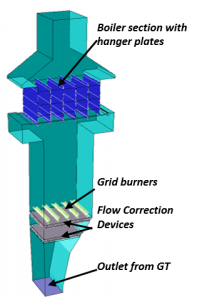
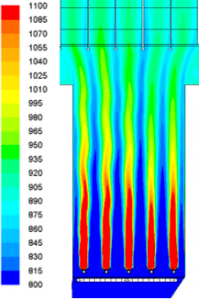
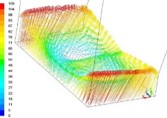
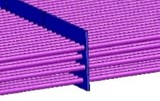

Our analysis and designed FCD, resulted in a flow distribution at all three loads within the operational range for the grid burners and an even temperature distribution, with a variation within 5 percent from mean upstream super heaters. The analysis provided detailed information about the temperature and heat flux distribution on the super heater tubes and fins. The investigation clearly showed the advantage of using CFD for designing and optimization of the flow and temperature distribution at different load conditions.
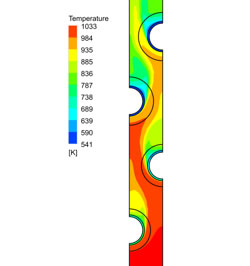
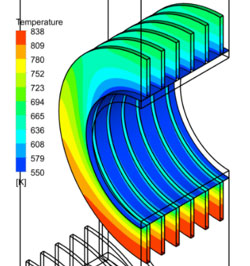
Temperature distribution
All simulations featured detailed geometries of both the OTSG and internals in a high-resolution structured meshes. The model included 3D turbulent simulations with eddy dissipation combustion modelling and the discrete ordinate model used for radiation heat transfer. We used different GT inlet profiles depending on the load as well as temperature dependent material properties.